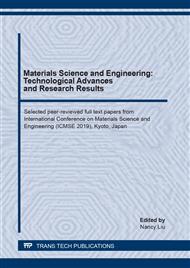[1]
A.P. Olukoya O, S. Kurt, Environmental impacts of adobe as a building material: The north Cyprus traditional building case, Construction Materials, (2016), p.32–41.
DOI: 10.1016/j.cscm.2015.12.001
Google Scholar
[2]
W.Y Vivian. T, N. Le Khoa, Sustainable Construction Technologies, Life-Cycle Assessment, Materials, (2019), pp.237-262.
Google Scholar
[3]
E. Creangă, I. Ciotoiu, D. Gheorghiu, G. Nash, Vernacular architecture as a model for contemporary design, Eco-Architecture III, WIT Transactions on Ecology and the Environment, Vol 128, WIT Press, (2010), pp.157-171.
DOI: 10.2495/arc100141
Google Scholar
[4]
G. Minke, Building with Earth: Design and Technology of a Sustainable Architecture, 2nd ed., Boston: Birkhaeuser Publishers for Architecture, Basel, Berlin, (2012).
Google Scholar
[5]
A. O. Ibrahim, The mud traditional architecture of the Sudan and Saudi Arabia: The difference in employment techniques, Qassim University, Saudi Arabia, (2018).
Google Scholar
[6]
J. Fernandes, R. Mateus, L. Bragança., The potential of vernacular materials to the sustainable building design, Taylor & Francis Group, London, (2014).
Google Scholar
[7]
Y.M. Benyoucef, A.D. Razin, Consideration of climatic conditions in the design of dwellings in the Sahara Desert. RUDN Journal of Engineering Researches, 19(4), (2018), pp.471-481.
DOI: 10.22363/2312-8143-2018-19-4-471-481
Google Scholar
[8]
E. Baglioni, Sustainable Vernacular Architecture: The Case Of The Drâa Valley Ksur (Morocco), Conference Paper, (2010).
Google Scholar
[9]
M. Salim, Terre crue : stabilisation naturelle, ENSAPM, Département Transitions, Paris, Séminaire de recherche, (2017).
Google Scholar
[10]
N. Dalkılıçn, A. Nabikoğlu, Traditional manufacturing of clay brick in thehistorical buildings of Diyarbakir (Turkey), frontiers of architectural research (2017).
DOI: 10.1016/j.foar.2017.06.003
Google Scholar
[11]
G. S Sruthi, Mud architecture, IJIRS, engineering and technology, ICEE, Volume 2, Special Issue 1, (2013).
Google Scholar
[12]
A. Vefik. Vernacular climate control in desert architecture. Energy and Buildings, (1990), pp.809-815.
DOI: 10.1016/0378-7788(91)90076-f
Google Scholar
[13]
Z. Zhai, J. M. Previtali, Ancient vernacular architecture: characteristics categorization and energy performance evaluation, energy and buildings, 42, (2010), p.357–365.
DOI: 10.1016/j.enbuild.2009.10.002
Google Scholar
[14]
Benyoucef M., Razin A.D. Contemporary vernacular architecture design for a Future design solutions of dwellings in hot-arid areas // Urban Studies. - 2019. - № 4. - С.73-82.
Google Scholar
[15]
H. Day. The Vernacular as a Model for Design: Design Studies for the contemporary Welsh House, (Ph.D. Thesis), Welsh School of Architecture, Cardiff University, (2013).
Google Scholar
[16]
A. G. Muazu, H. Z. Alibaba, The Use of Traditional Building Materials in Modern Methods of Construction, IJESTR, Volume – 2, Issue – 6, (2017), pp.30-40.
Google Scholar
[17]
Auroville Earth Institute. Earth Based Technologies, (2009). Available on: www.earthauroville.com/maintenance/uploaded_pics/4-cseb-en.pdf.
Google Scholar
[18]
N. Nadarajah. Development of concrete 3D printing, Thesis (Mater of Science in Building Technology), Aalto University, (2018), p.1.
Google Scholar
[19]
Z. Malaeb, H. Hachem, A. Tourbah, T. Maalouf, N. El Zarwi, F. Hamzeh, 3D concrete printing: machine and mix design, IJCIET, Volume 6, Issue 6, (2015), pp.14-22.
Google Scholar
[20]
A. Chiusoli, The first 3D printed House with earth (Gaia), 3dWASP, 29, (2018), available on: https://www.3dwasp.com/en/3d-printed-house-gaia/.
Google Scholar
[21]
S. Merniche, Enduit en terre crue: Stabilisation et résistance à l'eau, Matériau pour l'éco-conception, (2015).
Google Scholar


